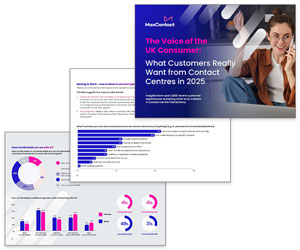The public sector contact centre industry faces unique challenges in delivering high-quality customer service to the general public while managing tight budgets and dated technology.
Here, we highlight several key themes and pain points impacting customer experience in 2024 across local governments in the UK.
Key Challenge #1: Slow Adoption of Digital Channels
One striking finding is the public sector’s low adoption of digital service channels compared to other industries. A recent report states:
“The public sector has some of the lowest take-up of digital channels of any sector, and telephony accounted for more than 80% of inbound interactions in 2018.
“However, 2020 onwards has seen a major increase in the use of telephony self-service, but this may be due to a drop in live telephony performance in the sector.”
While the central government has pushed for “digital-first” public services, progress has been slow.
Public sector contact centres still rely heavily on phone interactions. Depending on the nature of the interaction, transitioning more people to digital self-service, when done well, can reduce costs while still providing easy access to services.
To boost digital adoption, public sector organisations should:
- Ensure digital services are well-designed, easy to use, and accessible to everyone, including the elderly and underserved populations. Define the digital channels’ purpose and then build relevant, helpful content for your contact centre team and the customer-facing assets. Providing excellent support for digital channels will help build trust and confidence.
- Heavily promote digital options and educate people on how to use them.
- Provide easy access to phone service for complex issues or people who require it—don’t try to reduce demand by hiding this option. It only leads to dissatisfaction when people need it the most.
Key Challenge #2: Outdated Technology
Public sector contact centres tend to lag in implementing newer technologies like AI, analytics, and automation.
“The public sector is generally slow to implement new technology, and the relatively small size of many operations also means that it is behind the technology curve, particularly for newer technology such as AI, analytics and email management, as well as outbound-focused technology such as automated outbound diallers.”
Legacy systems can negatively impact public sector contact centre teams’ customer experience and operational efficiency.
Modernising the contact centre technology stack is crucial for handling interactions across channels seamlessly and extracting valuable insights from data across the public sector.
Some strategies to address outdated technology:
- Explore cloud contact centre platforms to reduce reliance on legacy infrastructure – which have feature limitations and lack integration options
- Consider point solutions, like outbound dialler technology – they help organisations to increase efficiency without the need to invest in long and complex digital transformation projects.
- Implement AI and automation in phases, starting with simpler use cases like AI-driven chatbots, web chat, and quality-of-life features that make communicating with customers more efficient.
Key Challenge #3: Worsening Speed to Answer
The general public’s expectations for fast service continue to rise, but public sector contact centres struggle to keep up. The report highlights a concerning trend:
“Public sector contact centres have usually seen a higher-than-average speed to answer, which has hugely risen since 2019 and is a concern.
“Some central government contact centres are under severe pressure to improve their performance, while local government operations will tend to have performance under better control, although their budgets are getting tighter, and they are forced to do more with less.”
Long wait times lead to frustration and more work for agents handling escalated complaints. Improving speed to answer requires a multi-pronged approach.
Tactics to try:
- Implement skills-based routing to match consumers’ requests with the best-equipped agent faster
- Expand self-service options for common requests to reduce live handle time; using tools like speech analytics helps operational leaders understand call drivers more accurately and shifts in conversation trends
- Explore callback technology to give people alternatives to waiting on hold
- Leverage workforce management tools to optimise scheduling and improve forecasting
Key Challenge #4: High Absence and Attrition
Agent engagement appears to be an emerging issue in public sector contact centres. Studies reveal:
“From 2017 until 2021, public sector agent absence rates were below the contact centre industry average. However, the high absence rate in 2022 and 2023 – in line with the jump in attrition and declining performance – is potentially cause for concern.”
Agents are the heart of the contact centre and directly impact customer satisfaction. High absenteeism and turnover disrupt operations and lead to inconsistent service levels as new agents are onboarded.
Some ways to combat absence and attrition:
- Invest in agent training and coaching to build confidence and competence
- Implement gamification to make work more engaging and rewarding
- Gather agent feedback regularly and take tangible actions to address pain points
- Provide clear career paths and opportunities for advancement
Key Challenge #5: Increasing Complexity and Cost to Serve
As people expect personalised, omnichannel service, interactions are becoming more complex for public sector contact centres to handle efficiently at scale. At the same time, budgets remain tight.
“Pent-up demand for phone service will continue to oppose the severe budget-cutting targets that exist at both central and local government levels, which are likely to cancel each other out to a great extent, leading to longer wait times and a greater likelihood of outsourcing, as little budget is available for growing the contact centre figures,” explains the report.
Organisations must find ways to do more with less, leveraging technology, data, and process improvements to reduce handle times and improve first-contact resolution.
Consider these strategies:
- Map customer journeys to identify and eliminate points of friction and unnecessary transfers
- Unify customer data across channels for a full view of interactions and context
- Analyse interaction data to surface opportunities for process improvement
- Implement knowledge management and AI tools to surface relevant information to agents quickly
In conclusion, while public sector contact centres face daunting challenges, a strategic approach incorporating new technology, enhanced self-service, and a continued focus on agent experience can help overcome these hurdles.
By making steady improvements across channels, technology, and operations, organisations can elevate the quality and efficiency of customer service while effectively managing costs.
With the right strategy and investments, public sector contact centres can deliver the convenient, personalised interactions customers increasingly expect, reinforcing trust in public institutions.
While not an overnight transformation, public sector leaders who commit to ongoing contact centre advancement can achieve meaningful progress in 2024 and beyond.
Source: Research public sector stats and quotes – “UK Contact Centre Verticals: Public Sector” (ContactBabel)
This blog post has been re-published by kind permission of MaxContact – View the Original Article
For more information about MaxContact - visit the MaxContact Website
Call Centre Helper is not responsible for the content of these guest blog posts. The opinions expressed in this article are those of the author, and do not necessarily reflect those of Call Centre Helper.
Author: MaxContact
Published On: 29th Apr 2024 - Last modified: 6th Dec 2024
Read more about - Guest Blogs, MaxContact






 MaxContact is the AI-powered customer engagement software that helps you turn every customer conversation into a high-impact, revenue-driving moment. We empower your teams to connect smarter, perform better, and scale faster – without losing the human touch.
MaxContact is the AI-powered customer engagement software that helps you turn every customer conversation into a high-impact, revenue-driving moment. We empower your teams to connect smarter, perform better, and scale faster – without losing the human touch. 
































